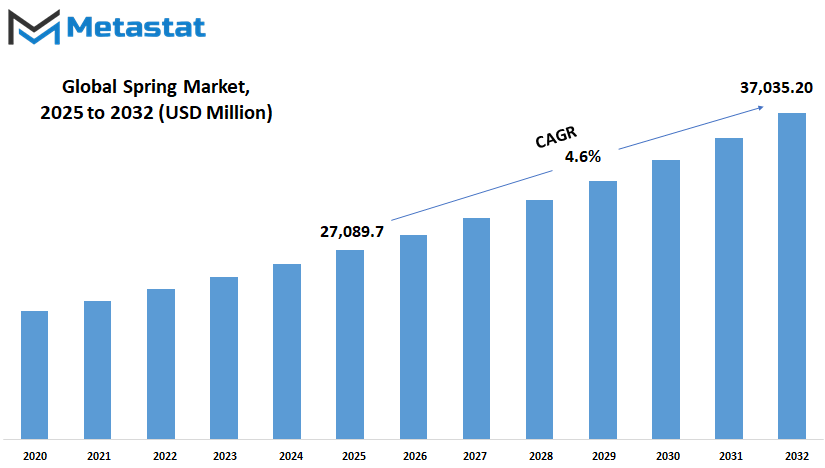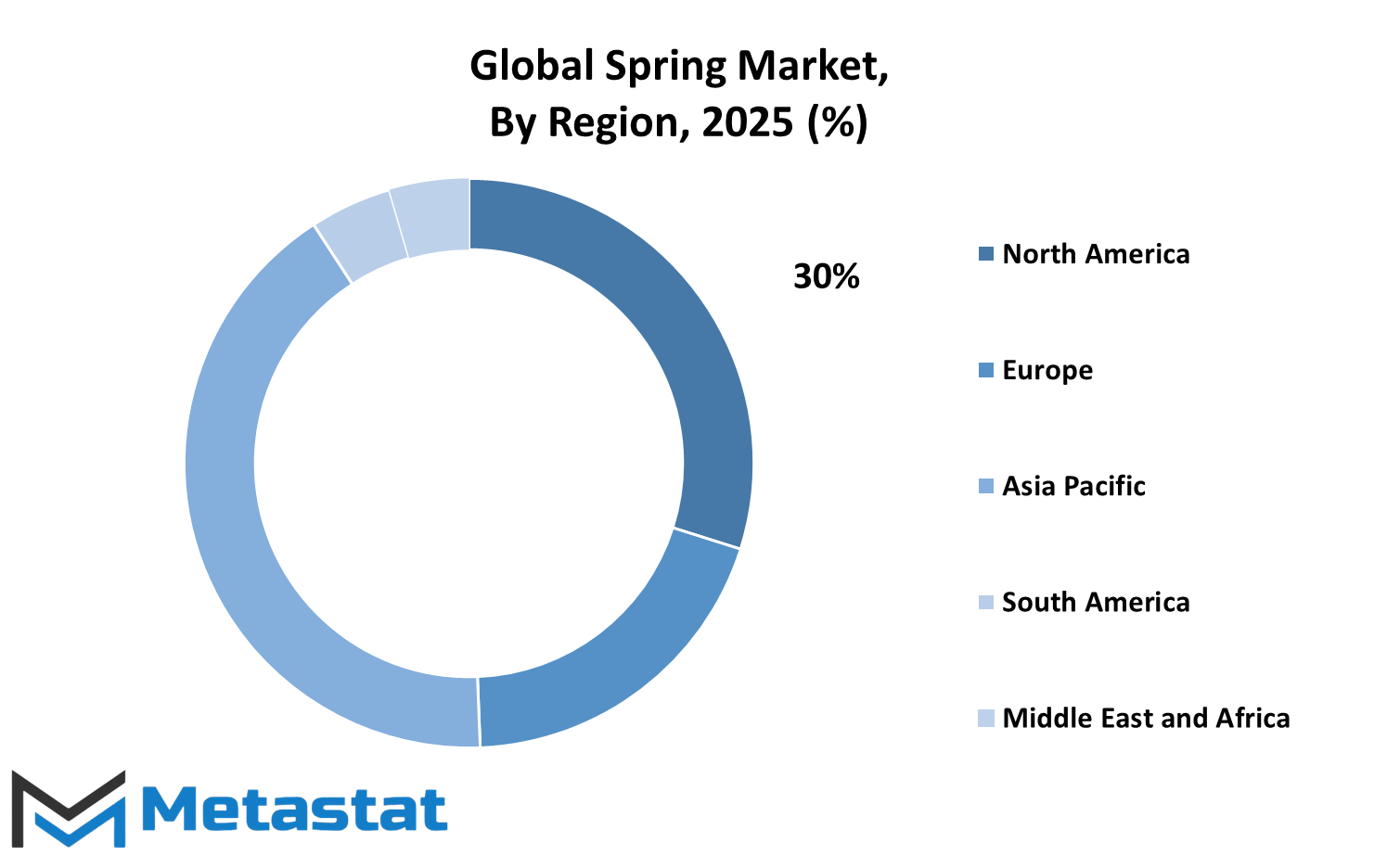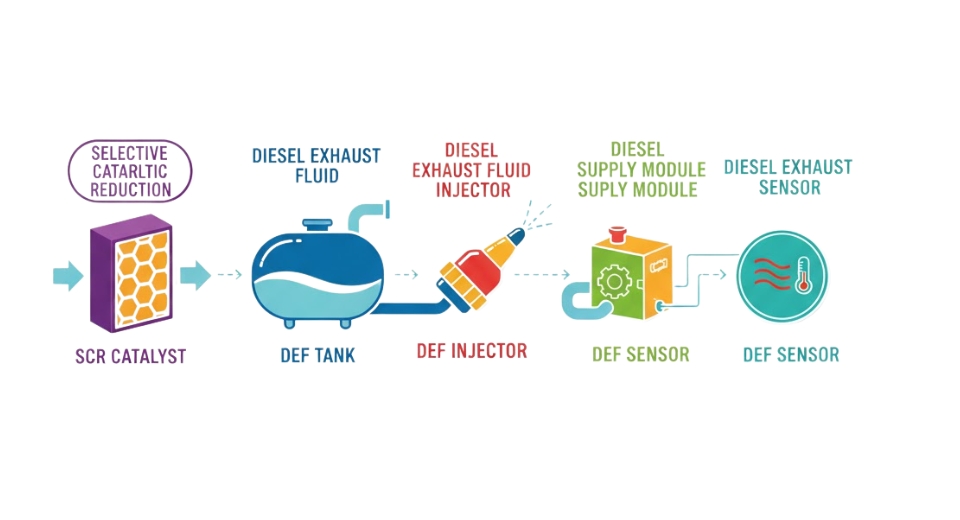MARKET OVERVIEW
The global spring market, which belongs to the sector of mechanical components and manufacturing, will continue to be a core segment underpinning a wide variety of industrial, automotive, aerospace, and consumer goods products and applications. Springs are mechanical devices with the ability to store and release energy, and therefore they have a long-term function as part of load-transmitting and motion control systems. With precision engineering increasingly determining design requirements in modern equipment, different kinds of springs such as compression, torsion, extension, and constant force springs will see an increase in demand with the trend towards upcoming application in every kind of industry.
This market will range extremely wide as it covers the needs of no single industry itself. Starting with miniature springs used in wearables to heavy coil springs used in suspension assemblies of industrial machinery and trucks, the global spring market will find its place in a wide range of end-use applications. In addition to meeting manufacturing needs of vintage mechanical devices, it will go to next-generation industries that put more focus on efficiency and reduction of size in mechanical components. The need for robust and high-performance materials such as stainless steel, copper alloys, and advanced composites will set the manufacturing and innovation strategy of the industry leaders.
The global spring market will illustrate multilayered sophistication, where purchasing decisions will be based on custom engineering, load ratings, environmental tolerance, and cycle life. It will no longer be dominated by volume production but will be dominated by performance, longevity, and reliability, especially in industries where mechanical failure would have high financial or safety implications. Aerospace engineering, medical devices, and precision instruments will need custom spring solutions to cater to high levels of stringent compliance requirements and rigorous testing levels.
Geographically, the global spring market will be dispersed across developed and emerging economies that will have different characteristics. The advanced manufacturing hubs will be anticipated to spearhead innovation, design, and material development, while the emerging markets will concentrate on low-cost supply chains and scalable production. The interaction between engineering service providers and OEMs will play a crucial role in solving design-specific needs, particularly for applications with close operational tolerances. With CAD technology and digital software becoming standard, design cycles will occur faster, still reducing manufacturing without compromising structural strength.
In scale, the global spring market will continue to stay in sync with machinery and mechanical system advancement and remain one of the most important facilitators of movement and load control. It will not be restricted to volumes but will allow small-scale, specialty manufacturing where springs perform specialty functions with high performance requirements. Manufacturability of processes will also begin taking on more significance with recycled metal and low-waste fabrication processes becoming increasingly valuable as regulatory regimes regarding waste and emissions become tighter.
As global engineering systems become increasingly interconnected and demand specificity in motion mechanics, the global spring market will remain pertinent by responding to both mass industrial demands and special product innovation. The range of the market being so broad ensures that it will remain fairly well-entwined with mechanical engineering developments, earning consistent demand in both established and emerging markets.
Global spring market is estimated to reach $37,035.20 Million by 2032; growing at a CAGR of 4.6% from 2025 to 2032.

GROWTH FACTORS
The global spring market is expected to experience radical changes in the forthcoming years, with a number of determinants driving and affecting its growth and challenges. The increase in demand from the automobile and industrial machine industries has emerged as one of the key drivers for this market. Springs are pivotal for these industries since they help maintain tension, ensure shock absorption, and ensure smooth functioning of different mechanical components. Along with this, the growth and expansion of such industries will increase the demand for reliable and efficient springs, which will propel the market ahead.
Along with this, the growing use of springs in consumer electronics and medical equipment also works in favor of the growth of the market. Modern electronics, such as smartphones, laptops, and more, utilize small and precise springs to function efficiently. Similarly, springs are used in a variety of medical devices, ranging from surgical equipment to implantable products, where precision and reliability are critical. Such increased deployment of springs in high-technology applications will create new prospects for manufacturers and suppliers.
Even with these favorable trends, some issues may impede the onward march of the global spring market. One of the main problems is raw material price volatility, which has a direct influence on cost of production. If prices rise unpredictably, producers will have more trouble with maintaining constant production or keeping prices competitive. It can make buyers hesitate and limit overall the global spring market growth. The danger also comes from alternative technologies being available, thus reducing the reliance on traditional springs. Technological innovation in other mechanical components or materials could replace springs in certain uses, thereby lowering demand in some markets.
Nevertheless, the future remains full of hopeful prospects in this market, most notably through material innovation suitable for springs. Lighter, corrosion-resistant new materials are being manufactured, which improve spring performance and lifespan. These developments will result in springs being more resilient, efficient, and usable in new fields, especially where weight and environmental durability are major factors of interest. These developments will open doors to companies that require high-quality springs but with strict specifications on material characteristics.
Overall, the global spring market will grow further due to strong demand from automotive, industrial, consumer electronics, and medical sectors. While there are issues such as material price fluctuations and competing technologies, the ongoing innovation in better spring materials offers promising opportunities for growth and development.
MARKET SEGMENTATION
By Product Type
The global spring market will definitely expand and develop largely in the forthcoming future. Springs are basic units used across multiple industries that serve a diverse range of purposes depending on their structure and material. Among the numerous springs, leaf springs, helical springs, and others dominate the market, each serving distinct functions in mechanical application. Leaf springs, being hard and robust, are used in heavy duty equipment and transport to support and cushion. Helical springs, with their spiral shapes, are often used in industry and consumer goods, and they offer flexibility and springiness. Under "others" fall a variety of specialist springs which have particular functions and which could be specifically manufactured according to technical specifications. The global spring market will expand in the future because industries require more efficient and more reliable components.
Growing application of springs in the automotive, aerospace, construction, and manufacturing sectors is driving the market. Breakthrough in material and manufacturing process will continue to enhance the functionality of springs by making them light, strong, and resistant to varied conditions. For example, advancements in spring structure and heat treatment will allow enhanced strength and resistance of springs so that they can support more stress and temperature.
In terms of value, the market for such springs is already considerable and will be very impressive by the end date indicated. This is owing to a combination of stable demand, technical innovation, as well as the emergence of new applications. With industries adopting smart and mechanized systems, springs will be the backbone for the smooth running of the same. The leaf spring industry will also maintain its position due to its ruggedness in high-load applications, while the helical spring industry will benefit due to its in-built versatility and common use in ordinary products
In addition, sustainability will be a key driver of the global spring market. Suppliers are set to turn their attention to environmentally friendly materials and production processes to minimize environmental footprint. Recycling and reuse of spring components may also become more prevalent as a wider move toward sustainable manufacturing.
Overall, the global spring market will see steady growth with its wide range of applications and ongoing technological innovations. The different products leaf springs, helical springs, and others will themselves support the growth as they cater to the needs of modern-day industries and future innovations. This will provide opportunities for companies to produce better products that respond to evolving needs while focusing on sustainability and efficiency.
By End User Industry
The global spring market will witness tremendous growth in the coming years as it is supported by numerous industries, which need springs to perform specific functions. The spring is a basic component that is affixed to most machines and buildings to offer flexibility, support, and energy storage. Springs will have a larger demand in the future as industries continue to evolve and new technologies come into existence.
In the transportation and automotive industry, springs play a vital role in vehicle suspensions, engine parts, and safety features. As technology advances in electric and autonomous cars, there will be a continually increasing demand for specialized springs. Specialized springs of greater durability, reduced weight, and performance will be required by such industries to cater to demands for new designs and increased safety features. With transportation going greener and more efficient trends, global spring market in spring season will follow along with these developments, manufacturing parts for enabling newer car technologies. Construction is also a sector that will drive the development of the global spring market.
Springs are used in construction equipment, machinery, and tools to make construction more efficient and stable. The increase in the volume of constructions around the world, including bridges, tunnels, and dwellings, will result in a steady level of demand for rough-condition springs and heavy-load springs. Smart buildings and automated equipment in new developments in building construction will also drive demand for more-featured springs, such as corrosion-resistant springs and longer-lasting springs. Agricultural and forestry sectors also depend significantly on springs in machines like tractors, harvesters, and others. Springs are used for shock absorption, maintaining tension, and smooth operation. With the development of equipment being brought about by automation and precision farming, the need for quality springs will increase.
Equipment producers would need springs that can function efficiently under stressful conditions while optimizing efficiency and minimizing maintenance requirements. Springs are employed in millions of production lines, tools, and machines used in manufacturing. With growing automation and technology across industries, demand for high-speed springs and accurate-motion springs will continue to grow. Springs that provide strength and reliability to handle sophisticated production techniques, such as robotics and sophisticated machinery, will be sought after by manufacturers.
Other industries will also drive the development of the worldwide spring industry by integrating springs in a variety of applications, including electronics, medical equipment, and consumer products. With continued advances in technology, industries will be looking for springs that are produced for specific applications, like miniaturization or high sensitivity.
Generally, the global spring industry's future is promising with consistent growth across various sectors. With each of these sectors further developing, springs will continue to be an important element, adapting to overcome new challenges and technological demands.
|
Forecast Period |
2025-2032 |
|
Market Size in 2025 |
$27,089.74 million |
|
Market Size by 2032 |
$37,035.20 Million |
|
Growth Rate from 2025 to 2032 |
4.6% |
|
Base Year |
2024 |
|
Regions Covered |
North America, Europe, Asia-Pacific, South America, Middle East & Africa |
REGIONAL ANALYSIS
The global spring market is going to see a radical transformation as different regions uniquely contribute their quota in its growth. If one considers the market from a geographical perspective, it can be easily understood how all the regions will uniquely contribute. North America, in turn, will continue to be in the lead position, especially with the United States leading the way in consideration of its state-of-the-art manufacturing expertise and the thirst for innovation. Canada and Mexico will also be important, supported by industrial development and increased use of high-tech technologies. These countries collectively will play a crucial role in shaping the market's future in this region.
Europe is another key region in the global spring market. The UK, Germany, France, and Italy are some of the countries that will be pivotal, supported by their established bases and focus on quality and precision. These nations are also expected to invest in new materials and technologies aimed at tapping growing needs from industries like automotive and machinery. The rest of Europe will also be part of this development, through smaller but more vital markets. Europe's heavy research and development emphasis is set to continue pushing the global spring market.
Growth is anticipated to be particularly rapid in the Asia-Pacific region. India and China will be spearheading the way, leveraging their enormous manufacturing bases and expanding domestic demand. Japan and South Korea will be close behind, as a result of their technological abilities and high quality of production. Other neighboring countries will provide support to this growth by having better industrial infrastructure and supply chains. The large population and growing economies in the Asia-Pacific region make it a forceful region that will set the future of the global spring market.
South America will register steady growth, and that will be driven by Brazil and Argentina. The potential within the region is to build more industrial ventures and boost economic stability. It may be smaller than other regions, but South America's contribution will become more pronounced as investment keeps increasing and local markets keep growing. The rest of South America will follow the same trend, partaking in the overall advancement.
The Middle East and African regions will also experience expansion in the global spring market. Egypt, the GCC countries, and South Africa will spearhead this change thanks to infrastructure projects and increasing industrial requirements. Other countries in these regions will increasingly follow suit with the assistance of emerging economic conditions and the rising interest in manufacturing.
Overall, the global spring market future will be determined by the ways in which these territories are developing and interacting with global trends. Each will bring unique strengths, and they will drive the market to develop increasingly and react to new challenges and opportunities.

COMPETITIVE PLAYERS
The global spring market will experience radical shifts as it continues to grow and develop with new technology and changing needs. Its future will be determined by the success of major companies in positioning themselves to address emerging needs. These companies will play a vital role in driving innovation and maintaining competitive advantage, positioning themselves to remain in relevance in a market that will become tougher and more dynamic over time.
There are many prominent companies that currently dominate the global spring market, each with individual strengths to meet diversified customer needs. GALA GROUP and Lesjöfors AB are some of these companies that have built a reputation for quality and trust, which will continue to be crucial as industries worldwide rely on spring components for their critical operations. Meanwhile, organizations such as Springmasters Ltd. and CARL HAAS GmbH have specialized in professional designs and advanced manufacturing technologies that will qualify them to supply sectors requiring precision and strength. This emphasis on quality production processes will be crucial to maintaining leadership positions.
Bal Seal Engineering and European Springs & Pressings Ltd. are among the companies that have expanded their range of products to offer beyond basic springs. Their ability to offer customized solutions and integrate innovative materials will increase their stake as customers ask for more customized and innovative products. Similarly, RS Components Ltd. and Trelleborg have placed a strong focus on extensive distribution networks and strategic alliances, which will allow them to reach more customers as world supply chains become more complex.
Delta Faucet Company, Small Order Springs & Pressings Ltd., and Lee Spring Company have built their brands on responsiveness and customer service, qualities that will become increasingly essential as markets demand faster turnaround and flexibility. The companies noted above's responsiveness to client needs and ability to do so efficiently will allow them to thrive in a world where speed and flexibility will be more important than ever.
In the years to come, companies like Metrol Springs, Michigan Steel Spring Co., and Coiling Technologies, Inc. will spend a great deal on research and development to develop smarter and more enduring spring solutions. These companies are aware that the future will call for parts that not only perform well but also last longer and work effectively in more advanced systems. This vision will allow them to make products that will be capable of keeping pace with technical advancements in various industries.
North Shore Steel and other smaller niche firms will also have continued opportunities by servicing niche markets and making products meet special technical requirements. Their speed will be a valuable asset in a market where customer orders will become more diverse and specific.
Overall, the Global Spring industry will be affected by these competitors who will focus on innovating, expanding their presence, and enhancing customer satisfaction. Their performance will dictate the extent to which the global spring market matures in reaction to new challenges and leverages nascent opportunities over the next couple of years.
Spring Market Key Segments:
By Product Type
- Leaf Spring
- Helical Spring
- Others
By End User Industry
- Automotive and Transportation
- Construction
- Agriculture & Forestry
- Manufacturing
- Others
Key Global Spring Industry Players
- GALA GROUP
- Lesjöfors AB
- Springmasters Ltd.
- CARL HAAS GmbH
- Bal Seal Engineering
- European Springs & Pressings Ltd.
- RS Components Ltd.
- Trelleborg
- Delta Faucet Company
- Small Order Springs & Pressings Ltd
- Lee Spring Company
- Metrol Springs
- Michigan Steel Spring Co.
- Coiling Technologies, Inc.
- North Shore Steel
WHAT REPORT PROVIDES
- Full in-depth analysis of the parent Industry
- Important changes in market and its dynamics
- Segmentation details of the market
- Former, on-going, and projected market analysis in terms of volume and value
- Assessment of niche industry developments
- Market share analysis
- Key strategies of major players
- Emerging segments and regional growth potential











 US: +1 3023308252
US: +1 3023308252






